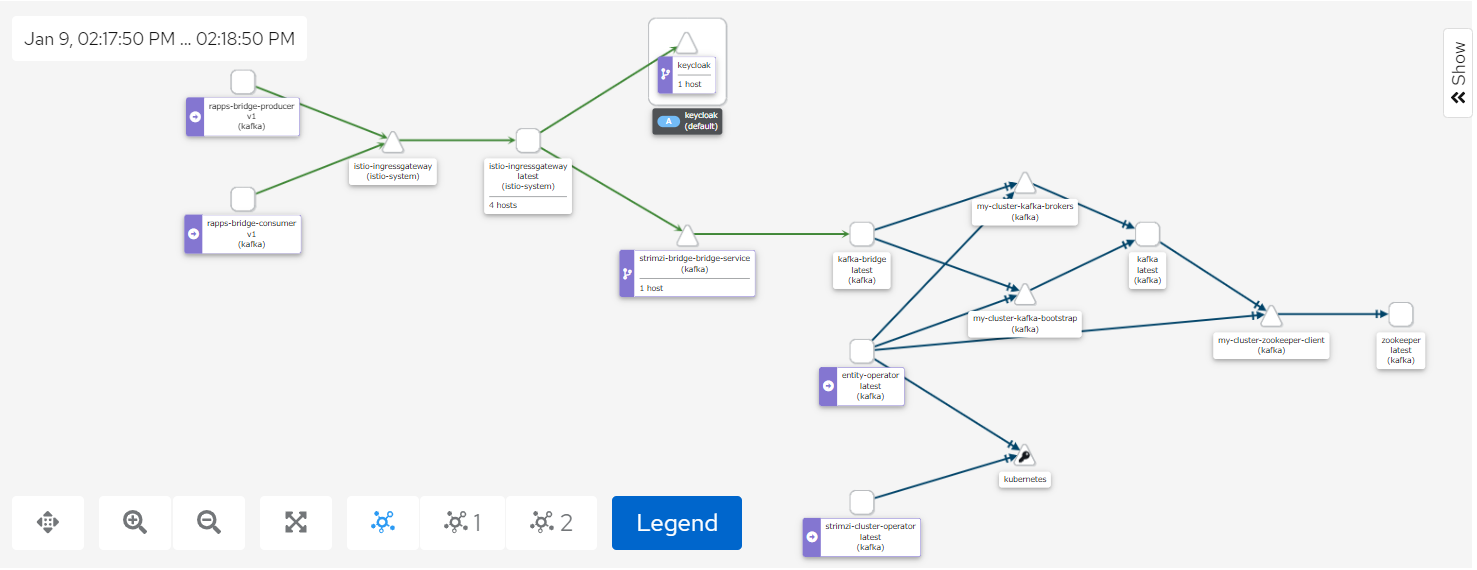...
Godaddy Opa Lambda Extension Plugin
GO
Go provides a library for opa.
...
opa bench --data rbactest.rego 'data.rbactest.allow'
+-------------------------------------------------+------------+
| samples | 22605 |
| ns/op | 47760 |
| B/op | 6269 |
| allocs/op | 112 |
| histogram_timer_rego_external_resolve_ns_75% | 400 |
| histogram_timer_rego_external_resolve_ns_90% | 500 |
| histogram_timer_rego_external_resolve_ns_95% | 500 |
| histogram_timer_rego_external_resolve_ns_99% | 871 |
| histogram_timer_rego_external_resolve_ns_99.9% | 29394 |
| histogram_timer_rego_external_resolve_ns_99.99% | 29800 |
| histogram_timer_rego_external_resolve_ns_count | 22605 |
| histogram_timer_rego_external_resolve_ns_max | 29800 |
| histogram_timer_rego_external_resolve_ns_mean | 434 |
| histogram_timer_rego_external_resolve_ns_median | 400 |
| histogram_timer_rego_external_resolve_ns_min | 200 |
| histogram_timer_rego_external_resolve_ns_stddev | 1045 |
| histogram_timer_rego_query_eval_ns_75% | 31100 |
| histogram_timer_rego_query_eval_ns_90% | 37210 |
| histogram_timer_rego_query_eval_ns_95% | 47160 |
| histogram_timer_rego_query_eval_ns_99% | 91606 |
| histogram_timer_rego_query_eval_ns_99.9% | 630561 |
| histogram_timer_rego_query_eval_ns_99.99% | 631300 |
| histogram_timer_rego_query_eval_ns_count | 22605 |
| histogram_timer_rego_query_eval_ns_max | 631300 |
| histogram_timer_rego_query_eval_ns_mean | 29182 |
| histogram_timer_rego_query_eval_ns_median | 25300 |
| histogram_timer_rego_query_eval_ns_min | 15200 |
| histogram_timer_rego_query_eval_ns_stddev | 32411 |
+-------------------------------------------------+------------+
OPA & Minio
OPA & MinIO's Access Management Plugin
OPA Sidecar injection
First create a namespace for your apps and enable istio and opa
...
Service Mesh and Proxies: Examples for Kafka
Setting up Strimzi bridge with Istio Authorization and ACLs
The Kiali screenshot above represents both a producer and a consumer connecting to Kafka through the Strmzi bridge.
Access to the bridge is controlled using JWT which is checked using an Istio AuthorizationPolicy.
| Code Block | ||||
|---|---|---|---|---|
| ||||
apiVersion: "security.istio.io/v1beta1"
kind: "AuthorizationPolicy"
metadata:
name: "kafka-bridge-policy"
namespace: kafka
spec:
selector:
matchLabels:
app.kubernetes.io/name: kafka-bridge
action: ALLOW
rules:
- from:
- source:
requestPrincipals: ["http://keycloak.default:8080/auth/realms/opa", "http://istio-ingressgateway.istio-system:80/auth/realms/opa"]
- to:
- operation:
methods: ["POST", "GET"]
paths: ["/topics", "/topics/*", "/consumers/*"]
when:
- key: request.auth.claims[clientRole]
values: ["opa-client-role"] |
By enabling tls on one of our bootstrap listeners user certificates are automatically created when we create a new KafkaUser
- name: tlsauth
type: internal
port: 9096
tls: true
authentication:
type: tls
Setting the authentication type to tls also ensure secure communication between Kafka and zookeeper.
We also set authorization to simple for the Kafka cluster, this means ACLs will be used.
kafka:
authorization:
type: simple
superUsers:
- CN=kowl
Any users you want to by-pass ACL checks should be listed under superUsers.
We can then setup our bridge user and include the ACL permissions as part of the KafkaUser definition:
| Code Block | ||||
|---|---|---|---|---|
| ||||
apiVersion: kafka.strimzi.io/v1beta1
kind: KafkaUser
metadata:
name: bridge
namespace: kafka
labels:
strimzi.io/cluster: my-cluster
spec:
authentication:
type: tls
authorization:
type: simple
acls:
# access to the topic
- resource:
type: topic
name: my-topic
operations:
- Create
- Describe
- Read
- Write
- AlterConfigs
host: "*"
# access to the group
- resource:
type: group
name: my-group
operations:
- Describe
- Read
host: "*"
# access to the cluster
- resource:
type: cluster
operations:
- Alter
- AlterConfigs
host: "*" |
Authorization between the bridge and Kafka is done using user certificates.
| Code Block | ||||
|---|---|---|---|---|
| ||||
apiVersion: kafka.strimzi.io/v1beta2
kind: KafkaBridge
metadata:
name: strimzi-bridge
namespace: kafka
spec:
replicas: 1
bootstrapServers: my-cluster-kafka-bootstrap:9096
http:
port: 8080
logging:
type: inline
loggers:
logger.bridge.level: "DEBUG"
logger.send.name: "http.openapi.operation.send"
logger.send.level: "DEBUG"
tls:
trustedCertificates:
- secretName: my-cluster-cluster-ca-cert
certificate: ca.crt
authentication:
type: tls
certificateAndKey:
secretName: bridge
certificate: user.crt
key: user.key |
Records can then to be posted to a topic with a call like this:
Endpoint:
http://istio-ingressgateway.istio-system:80/topics/my-topic
Payload: {"records":[{"key":"key-366","value":"value-366"}]}
and read from a topic using the following syntax:
i) Create a consumer group
Endpoint: http://istio-ingressgateway.istio-system:80/consumers/my-group
Payload: {"name":"my-consumer","format":"json","auto.offset.reset":"earliest","enable.auto.commit":false}
ii) subscribe to a topic
Endpoint: http://istio-ingressgateway.istio-system:80/consumers/my-group/instances/my-consumer/subscription
Payload: {"topics":["my-topic"]}
iii) Read records from a topic
Endpoint: http://istio-ingressgateway.istio-system:80/consumers/my-group/instances/my-consumer/records
These calls will be redirected to the bridge using a gateway and a virtual service
| Code Block | ||||
|---|---|---|---|---|
| ||||
apiVersion: networking.istio.io/v1beta1
kind: Gateway
metadata:
name: strimzi-bridge-gateway
namespace: kafka
spec:
selector:
istio: ingressgateway # use Istio gateway implementation
servers:
- port:
number: 80
name: http
protocol: HTTP
hosts:
- "*"
---
apiVersion: networking.istio.io/v1beta1
kind: VirtualService
metadata:
name: strimzi-bridge-vs
namespace: kafka
spec:
hosts:
- "*"
gateways:
- strimzi-bridge-gateway
http:
- name: "strimzi-bridge-routes"
match:
- uri:
prefix: "/topics"
- uri:
prefix: "/consumers"
route:
- destination:
port:
number: 8080
host: strimzi-bridge-bridge-service.kafka.svc.cluster.local |
Note: To use Kowl with this setup you'll need to create a kowl user and configure kowl to use tls
| Code Block | ||||
|---|---|---|---|---|
| ||||
apiVersion: kafka.strimzi.io/v1beta1
kind: KafkaUser
metadata:
name: kowl
namespace: kafka
labels:
strimzi.io/cluster: my-cluster
spec:
authentication:
type: tls |
| Code Block | ||||
|---|---|---|---|---|
| ||||
apiVersion: v1
kind: ConfigMap
metadata:
name: kowl-config-cm
namespace: kafka
data:
config.yaml: |
kafka:
brokers:
- my-cluster-kafka-0.my-cluster-kafka-brokers.kafka.svc:9093
tls:
enabled: true
caFilepath: /etc/strimzi/ca/ca.crt
certFilepath: /etc/strimzi/user-crt/crt/user.crt
keyFilepath: /etc/strimzi/user-key/key/user.key |
- ca.crt is obtained from the my-cluster-cluster-ca-cert secret, user.crt and user.key are obtained from the kowl secret.
Admission Controllers
An admission controller is a piece of code that intercepts requests to the Kubernetes API server prior to persistence of the object, but after the request is authenticated and authorized.
Admission Controllers Reference
Kyverno
Opa Gatekeeper
OPA Gatekeeper: Policy and Governance for Kubernetes
